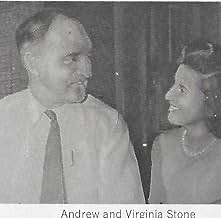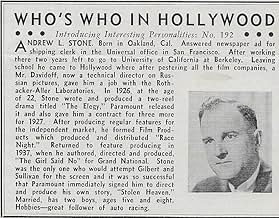Andrew L. Stone(1902-1999)
- Director
- Writer
- Producer
American writer-director-producer Andrew L. Stone attended the
University of California and then joined the San Francisco Film
Exchange. He began in Hollywood with Universal in 1918, serving his
initial apprenticeship in a film laboratory. After several more years
of toil in Universal's prop department he graduated to directing short
films. He financed his first two-reel effort,
The Elegy (1927), himself. The following year he helmed
his first feature film. Stone could hardly be
described as a prolific film maker until at least the late 30s when
he began contributing several story lines for light entertainments,
such as
There's Magic in Music (1941)
and Hi Diddle Diddle (1943). He
achieved his first critical acclaim as a director for his all-black
musical Stormy Weather (1943),
starring the exuberant Lena Horne. The New
York Times (July 22) praised Stone's 'knowing direction' and the film
as 'moving smoothly' and 'being paced just right'.
Stone worked under contract at Paramount (1938-41), United Artists (1943-47) and MGM (1955-62). In 1943, he set up his own production company as a means of attaining a greater measure of creative independence. Commencing with Highway 301 (1950), he proceeded to turn out a brace of commercially successful minor thrillers, films noirs and action pictures. Scornful of back-projection and post-synchronisation, he shot these films in real locations (rather than at studio facilities) for added realism, moreover, using genuine infrastructure (aircraft, trains, ocean liners) in preference to props. Some of his projects were also based on actual events, gleaned by researching factual crime magazines (of which Stone received up to eight per month on subscription). Regarded as the best among Stone's thrillers are The Steel Trap (1952) and Cry Terror! (1958).
He frequently worked in tandem with his wife Virginia L. Stone who acted as musical editor and financial supervisor. Stone's career ended rather abruptly after two lavishly-produced composer biopics, Song of Norway (1970) and The Great Waltz (1972), ended up being massive commercial failures. Nonetheless, his significant contribution to the concept and mechanics of on-location shooting was recognised with a star on the Walk of Fame on Hollywood Boulevard.
Stone worked under contract at Paramount (1938-41), United Artists (1943-47) and MGM (1955-62). In 1943, he set up his own production company as a means of attaining a greater measure of creative independence. Commencing with Highway 301 (1950), he proceeded to turn out a brace of commercially successful minor thrillers, films noirs and action pictures. Scornful of back-projection and post-synchronisation, he shot these films in real locations (rather than at studio facilities) for added realism, moreover, using genuine infrastructure (aircraft, trains, ocean liners) in preference to props. Some of his projects were also based on actual events, gleaned by researching factual crime magazines (of which Stone received up to eight per month on subscription). Regarded as the best among Stone's thrillers are The Steel Trap (1952) and Cry Terror! (1958).
He frequently worked in tandem with his wife Virginia L. Stone who acted as musical editor and financial supervisor. Stone's career ended rather abruptly after two lavishly-produced composer biopics, Song of Norway (1970) and The Great Waltz (1972), ended up being massive commercial failures. Nonetheless, his significant contribution to the concept and mechanics of on-location shooting was recognised with a star on the Walk of Fame on Hollywood Boulevard.

























